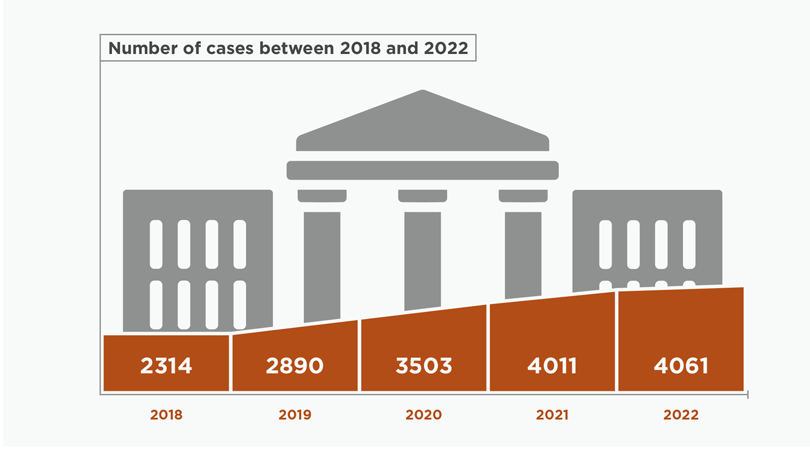Accessibility lawsuits have been on the rise annually for years now. As we head into the 2024 year, it’s more important than ever before for businesses to make sure that they understand how accessibility law can impact their business and what they can do to protect themselves from digital accessibility lawsuits and make a positive impact on the accessibility of their digital properties.
So let’s talk about how we got here, where we think we’re going next, and steps you can take now to consider digital accessibility.
Editor's Note: This blog is based on our March 10, 2020 Webinar, featuring Chuck Marion, Partner at Blank Rome, and Jason Taylor, CIO at UsableNet. Register now and get a copy of the recording to watch on-demand as soon as it's released! Register to watch.
Web Accessibility in 2024: How We Got Here
Here’s a quick recap of how we got here:
- The ADA was enacted in 1990, prohibiting discrimination based on disability in places of public accommodation, which at the time were all physical locations
- Blind individuals and organizations later brought up early court cases brought up digital accessibility.
- In 2003, the DOJ released its Voluntary Action Plan with tips to make websites more accessible.
- Up through 2015, the DOJ supported several private website accessibility lawsuits, filing “statements of interest” in them.
- In 2017, DOJ involvement in web accessibility cases slowed, and in 2018, the Assistant Attorney General sent a letter stating that businesses were permitted flexibility in compliance.
- Private website accessibility lawsuits for ADA rose after the DOJ stepped back, notably increasing from only 814 in 2017 to 2,314 by 2018.
The image below is from our 2022 end-of-year lawsuit report and shows that ADA-based digital lawsuits have grown yearly since 2017. The 2023 lawsuit report has yet to be released, but preregistration to receive the report is open now. Pre-register now.

The DOJ Is More Active in 2023: What This Means
Since the last administration turnover, the DOJ has become more active with digital accessibility. We expect that this will continue.
In 2022, the DOJ's guidance determined that Title III of the ADA applies to all goods, services, privileges, and activities offered by public accommodations online. They addressed:
- the importance of web accessibility, including how it’s a priority for the DOJ;
- typical barriers inaccessible websites create;
- when the ADA requires web content to be accessible and
- tips on making accessible web content
The 2022 guidance did not provide clear web accessibility guidance, such as a web accessibility standard businesses must achieve, like WCAG 2.1 AA, typically cited the most in ADA claims.
The DOJ also did not address if a physical nexus is required for plaintiffs to bring a web accessibility claim under the ADA.
Learn more about the history of the ADA, the rise in web accessibility lawsuits, and potential settlement costs in A Primer on ADA and Digital Accessibility- Download now.
Regulation that may impact web accessibility in 2024
The rise in ADA lawsuits around digital properties has raised awareness among businesses and lawmakers who want to offer relief for companies and more precise standards.
Several bills have been proposed to amend the ADA and clarify website accessibility requirements.
The Online Accessibility Act was introduced in the last Congress and reintroduced in this one, the act would:
- create a new Title VI for websites and apps;
- designate WCAG 2.0 AA as the standard for website accessibility and require “substantial” (rather than complete, 100%) conformance;
- require a claimant to exhaust specific administrative remedies before filing a lawsuit; and
- likely not prevent state court lawsuits.
Another bill proposed, The Websites and Software Applications Accessibility Act, would
- clarify that it is unlawful for entities covered by the ADA to maintain inaccessible websites and apps that exclude or otherwise discriminate against people with disabilities;
- establish (and periodically update) clear, enforceable accessibility standards (to be set by DOJ and EEOC); and
- establish a technical assistance center and advisory committee to provide advice/guidance on accessible websites and apps.
A notable web accessibility law proposed at the state level is California's AB 1757, initially proposed in June 2023.
In August 2023, the bill's author requested that it be held in committee, but it will likely be considered and worked on further in 2024. AB 1757 would impose heightened standards on websites and mobile apps for accessibility.
If passed, AB 1757 could lead to even greater litigation and liability for businesses. It would:- make Web Content Accessibility Guidelines (WCAG) 2.1 AA the de facto standards for websites and mobile apps of business establishments open to the public;
- impose statutory penalties for non-compliance; and
- expose both business owners and web developers to potential liability.
In 2023, Kansas passed the Kansas Act Against Abusive Website Access Litigation, this law does the following:
- allows Kansas businesses to sue ADA plaintiffs and their counsel to recover fees (and potentially damages);
- applies a 5-factor test considering the totality of the circumstances; and
- “sunsets” if the DOJ issues website accessibility regulations.
It’s also important to consider that there are international regulations to consider, including the European Accessibility Act and the Accessibility for Ontarians with Disabilities Act.
Web Accessibility DEcisions in the Courts
We've seen time and time again in our bi-annual reports that court decisions impact the volume and place where plaintiffs file ADA-based website accessibility lawsuits. Businesses must look to the court rulings in place of clear guidance from the DOJ or clarity from regulation.
What have the courts done to clarify web accessibility as we move into 2024?
The U.S. Supreme Court
- denied cert. in Robles v. Domino’s Pizza case (from the 9th Circuit).
- Last week, the US Supreme Court announced that it would not decide who wins Acheson Hotels, LLC v. Laufer. All nine Supreme Court justices agreed the case was moot and should not be decided.
In New York:
- There have been decisions that found websites are, on their own, places of public accommodation.
- Some judges appear to be becoming skeptical of serial plaintiffs, applying more stringent standing requirements.
In California:
- There have recently been some cases in both state and federal courts that stated a nexus is required between the website and the business's physical location.
In Florida:
- Since Winn-Dixie, there hasn't been a lot of clarity around digital accessibility and ADA, so private lawsuits have continued steadily.
ADA AND WEB Accessibility Lawsuits Going into 2024
Today, when we talk about web accessibility, we have to look at web accessibility lawsuits for guidance and to understand what customers with disabilities need from businesses for an accessible experience when they are online.
Most digital accessibility lawsuits are filed by blind or visually impaired plaintiffs who rely on screen readers. However, hearing-impaired plaintiffs bring some with a common complaint: a lack of closed captioning.
We are waiting on end-of-year ADA lawsuit numbers, but we can make a few predictions for 2024 based on midyear trends:
- 80+ lawsuits are filed weekly- there is no reason for plaintiffs to slow this pace
- New York, Florida, and California are the top three states for suits filed - if you sell goods or services to these states, plaintiffs can file a lawsuit, even if your company is not headquartered there.
- Increasingly, lawsuits cite companies that have installed “accessibility widgets” or overlays.
While ADA lawsuits are focused most heavily on the eCommerce industry, no company with an online presence is immune; if you are a one-person shop, you can still receive an ADA digital accessibility lawsuit.
Some lawsuits are brought as class actions, while others are individual plaintiffs, and many reference a lack of an accessibility statement. Some also make administrative claims.
And when it comes to case trajectories, there are common patterns:
- Many cases settle in the early stages
- Few cases have been dismissed in certain jurisdictions (although most have been reversed/reinstated on appeal)
- Most settlements are confidential. However, some believe memorializing settlement through a consent decree will help deter subsequent lawsuits asserting the same claim.
For class actions, no disputed class certification motions have been decided yet. A few classes are certified for settlement purposes. This can have pros and cons.
What to do if you receive a lawsuit Now
Defendants should speak with an experienced defense attorney who can advise them on how to reply and a possible defense strategy like:
-
- Personal jurisdiction
- Lack of standing
- Mootness
- No nexus
- Use of accessibility widgets or tools
- Ascertainability (for class action suits)
- No intentional discrimination (particularly regarding state laws)
If your company receives a civil rights lawsuit for web accessibility or a demand letter, it's best to speak with an ADA attorney for advice on the next steps.
What Businesses Can Do to Increase Accessibility
There are a few best practices you might consider to make your website more usable for people with disabilities as you plan your accessibility initiative for 2024.
Here are a few ideas to get you started:
- Run an automated scan of your website with UsableNet's AQA free test for a report of conformance issues, code errors, and recommended fixes. Test now.
(You'll want to eventually conduct a full audit that includes manual and user testing with the disability community, but an automated test is a good place to start). - Post an accessibility statement on your site
- Have a “hotline” people can call or email if they need assistance using your website
- Train your team on how they should handle calls regarding website accessibility
- Consider liability insurance
- If you need outside help, skip the widgets and invest in an experienced accessibility partner
- Select partners that can help you improve your accessibility - Web Accessibility Agency Questions to Ask
Ready to increase digital accessibility and protect your business from increasing lawsuits? Learn about Usablenet’s accessibility services here.
Interested in learning more about our digital roadmap to accessibility and how to document each stage? Register to watch the webinar here
Please note: This blog is based on a December 6 Webinar by the same name. Attendees should consult with counsel before they take any action and should not consider these materials or discussions about these materials to be legal or other advice.






